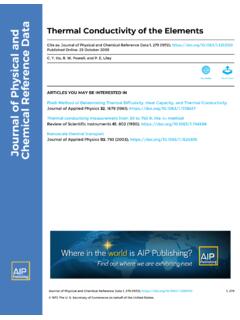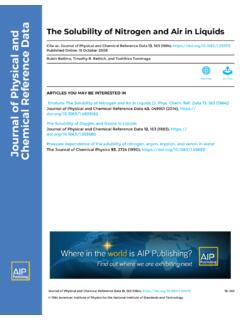Transcription of Tables of molecular vibrational frequencies - NIST
1 Journal of Physical and Chemical Reference Data 7, 1323 (1978); , 1323 1978 American Institute of Physics for the National Institute of Standards and of molecular vibrational frequenciesCite as: Journal of Physical and Chemical Reference Data 7, 1323 (1978); Online: 15 October 2009 Takehiko Shimanouchi, Hiroatsu Matsuura, Yoshiki Ogawa, and Issei HaradaARTICLES YOU MAY BE INTERESTED INTables of molecular vibrational frequencies . Consolidated volume IIJournal of Physical and Chemical Reference Data 6, 993 (1977); of molecular vibrational frequencies Part 5 Journal of Physical and Chemical Reference Data 1, 189 (1972); of molecular vibrational frequencies Part 10 Journal of Physical and Chemical Reference Data 9, 1149 (1980); of molecular vibrational frequencies Part 9 Takehiko Shimanouchi, * Hiroatsu Matsuura, ** Yoshiki Ogawa, and Issei Harada Department of Chemistry, Faculty of Science, University of Tokyo, Bongo, Bunkyo-ku, Tokyo 113, Japan Fundamental vibrational frequencies of 109 molecular forms of 38 polyatomic chain molecules consisting of the CHJ, CD3, CH2, CD2, CHD, 0, and S groups are given as an extension of Tables of molecular vibrational fre-quencies published in the NSRDS-NBS publication series and in this journaL On preparing the Tables in this part, an approach, different from that in the previous parts, based on the calculations of normal vibration fre-quencies was adopted.
2 A set of force constants which explains all the frequencies of small molecules for which the assignments had been established was obtained and then the frequencies of larger molecules were calculated and compared with the frequencies observed in the infrared and Raman spectra. The Tables provide a convenient source of information for those who require vibrational energy levels and related properties in molecular spec troscopy, thermodynamics, analytical chemistry, and other fields of physics and chemistry. Key words: Force constants; fundamental frequencies ; infrared spectra; normal vibrations; polyatomic molecules; Raman spectra; vibrational frequencies . 1. Introduction .. 2. Molecules Selected .. 3. Calculation of vibrational frequencies Computer Programs and Calculation.
3 Atomic Masses and Structural Parameters .. Local Symmetry Coordinates .. Force Constants .. 4. Description of Tables .. Symmetry .. Symmetry Number .. __ _ Symmetry Species .. Observed frequencies .. vibrational Assignment .. 5. Appendix .. 6. Acknowledgments .. 7. References .. Contents Page 1323 1324 1324 1324 1324 1324 1325 1332 1332 1332 1332 1332 1332 1333 1333 1333 8. List of Tables of molecular vibrational Frequen-cies .. , .. Table 1. Table 2. Table 3. Table 4. Table 5. List of Tables Atomic masses and structural paramenters used in the calculations .. Definition and symbolism of local sym-metry coordinates .. Force constants of paraffins .. Force constants of ethers .. Force constants of sulfides .. Table 6. Force constants of thiaethers .. Tables of molecular vibrational frequencies No.
4 I-No. 109 .. Page 1334 Page 1325 1326 1327 1328 1330 1331 1336 1. Introduction ESlablishing {he assignmem of mulecular viLraliuIlai fre-quenciesl has fundamental importance in elucidating various problems in physics and chemistry. The information concern- Prosent address: College of Information Scienc Uni .. "ity of Tsukuba, Sakura mura, Ibaraki 300-31,Japan. Present address: Department of Chemi5tn, Faculty of Science. Hiroshima Uninrsit" ing the force field and the motion of atoms in a molecule can be most directly derived from its vibrational frequencies . If all the vibrational frequencies of a molecule are known as well as the molecular structure, thermodynamic quantities can be easily computed on the ideal gas model. Thus the need for a tabulation of evaluated reference data on molecular vi-brational frequencies has often been felt by many investi-gators.}
5 I FoBo .. ing common U~Qgc, the h;Tm " \ hC9ucncic:.:-' 1~ \l~cd in \hi~ ~C'Ti<.'~. C''''('>n thuu~h numerical vaJues are givE."n for thr equivalent in unit5 of em-I. 1978 by the Secretary of Commerce on behalf of the United States. This copyright is assigned to the American Institute of Physics and the American Chern ical Society. 0047-2689/78/4129-1323 $ In 1964 a project for producing such Tables was initiated at the University of Tokyo in cooperation with the National Standard Reference Data System of the National Bureau of Standards. The evaluated data resulting from this project have been published as Tables of molecular vibrational Fre-1323 J. Phys. Chem. Ref. Data, Vol. 7, , 1978 1324 SHIMANOUCHI ET AL quencies, Part 1 [l)2, Part 2 [2], Part 3 [3J, Part 4, Part 5 [4), Part 6 [5], Part 7 [6], and Part 8 [7], and as the Consolidated Volumes I [8] and II [9].]]]
6 These two volumes consist of the contents of the above eight parts, after revision in the light of new experimental data, and give a reliable set of fundamental [n:yueJJcie:s fur 435 Lii:sic JJJulecule:s. On preparing these Tables of frequencies we chose the mol-ecules for which almost all the required data were available from the infrared and Raman spectra, and we selected the most probable .values of frequencies with a judgment of the accuracies of the values. In the course of preparing these Tables we noticed that the further extension of the Tables is limited, since for larger molecules the number of fundanwn-tal vibrational frequencies increases and it becomes more and more difficult to observe all of them in the infrared and Raman spectra. Accordingly we decided to adopt a different approach for preparing the further extension of such Tables .]
7 The present article is the first of this series. In the present approach we first tried to determine a Sf2>t of force constants which explains all the frequenciet; of Q group of small molecules for which the assignments had already been established. Then we calculated the frequencies o'f larger molecules and compared them with the observed when they were avaIlable. We chose the chain molecules consisting of the CH3, CD3, CH2, CD;z, CHD, 0, S, F, CI, Br, and I groups. The result was successful as shown in a series of pa-pers entitled "Vibration Spectra and Rotational Isomerism of Chain Molecules" [l0-15]. The agreement between the calculated and the observed was less than 10 cm-t with a few exceptions and shows that the frequency Tables given by adopting this approach can be used as the extension of those of Parts 1-8.
8 In the present article we give the Tables of force constant~ used and Tables of the calculated and observed frequencies of basic paraffin, ether, sulfide, and thiaether molecules. We have suitable computer programs for calculating the frequen-cies of larger molecules, and we are prepared to perform the calculations and make the rc:'mit5 availaLlt: [UI allY mulecule upon request, provided that this is within the capa city of our programs. 2. Molecules Selected The present part contains Tables of fundamental vibration-al frequences for 109 molecular forms of 38 chain molecules consisting of the CH3, CH2, 0, S, and their deuterated atomic groups. The molecuies are limited to those with four to six atomic groups except for the polymers (CH2)", (CD2}", (UCH2CH2)m (OCD2CD2)n, (SCH2CH2)" and (SCD2CD2)n.)]
9 Ro-tational isomers included have been confirmed to exist except for the GG form of CH3CH20CH2CH3 The following mole-('Illp ..:; Brp not induded in the Tables : moleculcG huving the 00, SS, and XCH2 Y groups where X and Yare neither CH3 nor CH2 A Jist of the molecules covered here is given at the beginn-ing of the Tables . The molecules are numbered starting with number I instead of continuing the designations of Part 8 of the Tables , since the present part gives fundamental vibra-2 Figures in brackets indicate literature reference. in section 7. J. PhY$. Chern. Ref. Doto, Vol. 7, , 1978 tional freljw'l1('i(':-; hy ad()pting an approach different from that in the pn'\iou:-; p;}rl~_ 3. Cnlcu~ntion of Vibrntionnl Fr@lqul9ncios; Computer Programs and Calculation The progranls llsed are based on a package ot programs GCCC, BGLZ, LSMB, and LXZ prt'pared in our laboratory [16].)))
10 These programs were combined by Y. Alaki, Y. Omura, and H. Matsuura to NCTB which produces vibrational fre-quencies, vibrational modes and other data from the molecu-lar structure and the force constants. It also can produce the force constants from the calculated and obsened frequencit's by the least-squares procedure. In addition to NCTB we developed a program system named MVIB which is of the interacting type and i!:i wwd for the remote TSS terminal. It was combined by H. Matsuura from NCTB2 reyised from NCTB for this purpose and IN-PUT2 prepared by Shirley S. Hui which gives a set of input data for NCTB2 from the molecular formula and the indica-tion of the conformation. TIlt:" MVIB :ilt.:1II u:se:; lhl' struc-ture and force constant data stored in the computer files and calculates the frequencies and other data from the molecular formula with the conformation.




